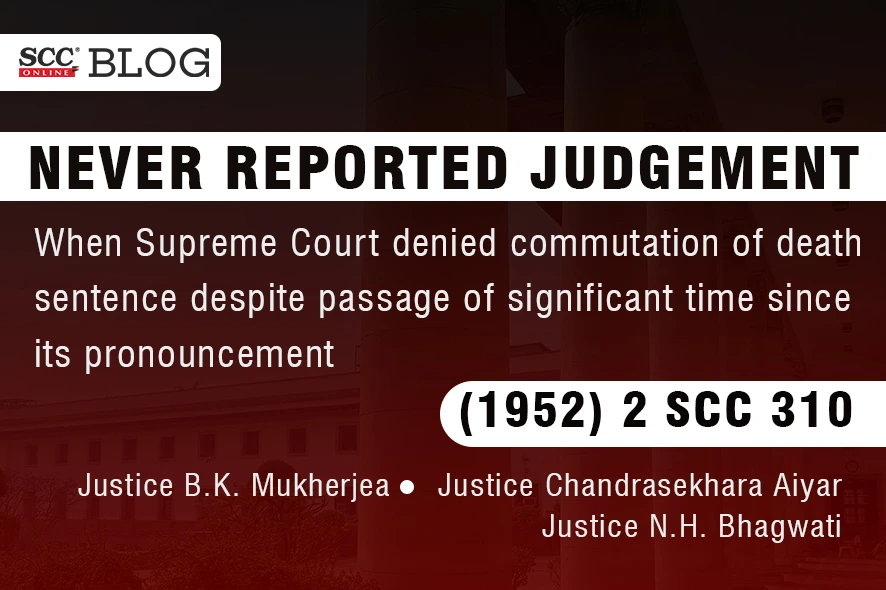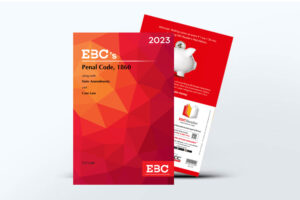Supreme Court: In an appeal filed against the judgment dated 20-04-1951, whereby the death sentence of the appellants for an offence under Sections 302 and 34 of the Penal Code, 1860 (‘IPC’) was affirmed, the three-judges bench of B.K. Mukherjea*, Chandrasekhara Aiyar and N.H. Bhagwati, JJ., opined that it was undisputed that when a long time period had elapsed after the pronouncement of a death sentence, it should be taken into consideration in deciding whether the death sentence should be enforced. However, at the same time when the Court had to exercise its discretion in the matter, it should take into account all the circumstances of the case and in the present case, considering the nature of the crime and circumstances under which it was committed, there was not any extenuating factor. Therefore, the present case was not a fit case where a commutation of death sentence should be made and accordingly, dismissed the appeal.
Background
On 11-10-1950, one of the witnesses in the present case, Jagir Singh, was engaged in cutting fodder in a field and when he heard the report of a gunfire coming from the direction of a footpath, which was going towards Chuhar Chak village, he stood up and saw his brother Pritam Singh running towards the village followed by the two appellants and the assailant Jagir Singh, who had been absconding since then. It was stated that both the appellants were armed with gun or rifle while the assailant Jagir Singh had kirpan in his hand.
At the same time, the other witnesses, Nazar Singh and Mahla Singh were working in the neighbouring fields and they as well as the witness Jagir Singh ran towards the spot from where Pritam Singh was running. The two appellants fired shot at Pritam Singh who died immediately and when the appellants noticed Ralla Singh who was proceeding towards his own home, they ran towards him and fired at him, and the assailant Jagir Singh cut off his head with kirpan. The three witnesses, Jagir Singh, Mahla Singh and Nazar Singh, who saw the incident, raised an alarm and ran towards the village.
After the occurrence, various persons including a former Zalidar were brought to the spot and they guarded the dead bodies. No steps were taken to inform the police during the night and on the following day, an FIR was lodged. Thereafter, Sub-Inspector reached the place of occurrence and found a shotgun cartridge sticking to Pritam Singh’s body near one of the gunshot injuries and one .303 rifle cartridge was found near Ralla Singh body.
The Trial Court opined that the appellants had sufficient motive for committing the crime and convicted both the appellants under Sections 302 and 34 of the IPC and sentenced them to death based primarily on the evidence of the three eyewitnesses. The High Court affirmed the judgement of the Trial Court and sentence of both the appellants were upheld vide judgment dated 20-04-1951.
Thereafter, the appellants filed the present appeal before the Supreme Court. The appellants contended that:
-
That the medical evidence adduced in the present case was contradictory, as according to the evidence of the eyewitnesses, the assailants were pursuing the victims who were running in front of them and if the shots were fired from behind, the injuries must appear on the back portions of their bodies, and not the places mentioned in the post-mortem reports;
-
There was no proper compliance with the provisions of Section 342 of the Criminal Procedure Code, 1878 (‘CrPC’), and that had prejudiced the accused at their trial.
-
Considering that a long period of time had elapsed since the death sentence was pronounced upon the appellants, the extreme penalty of law should not be enforced.
Analysis, Law, and Decision
Considering the appellants’ first contention, the Supreme Court opined that these matters were related entirely to appreciation of the evidence adduced at the trial by the courts and as there was no question of any grave irregularity in the procedure or violation of any mandatory provision of law which led to miscarriage of justice. The Supreme Court opined that the discrepancies and contradictions in the present case, had been fully considered by both the courts and then they came to concurrent findings upon which the appellants had been convicted. Further, the Supreme Court also opined that the medical reports did not show that the injuries were in front portions of the victims bodies and the Trial Court relied on the post-mortem reports as supporting materially the evidence of the eyewitnesses.
Further, with regard to the second contention of the appellants, the Supreme Court opined that it could not be disputed that Section 342 of the CrPC was an important and a salutary provision of law and it was the duty of the criminal courts to see that its requirements were properly complied with. The Supreme Court relied on Tara Singh v. State, 1951 SCC 903, wherein it was held that any error or omission of Section 342 of CrPC would not necessarily vitiate a trial. The Supreme Court opined that Section 342 of the CrPC provided that the accused should be examined to enable him to explain any circumstances which appeared in the evidence against him and if, any evidence was considered material by the court that the conviction should be based upon it, it was right and proper that if the accused desired, he should be questioned about it and opportunity to explain should be given to him.
The Supreme Court opined that in the present case, the points in issue are free from any complexity and the questions put forth to the accused under Section 342 of CrPC could not be said to be inadequate and the examination had not prejudiced them in any way. The absence of any specific question to the accused as to what they had to say against the evidence of the eyewitnesses in the circumstances of the present case was immaterial.
Considering the third contention of the appellants, the Supreme Court opined that it was undisputed that when a long time period had elapsed after the pronouncement of a death sentence, it should be taken into consideration in deciding whether the death sentence should be enforced. However, at the same time when the Court had to exercise its discretion in the matter, it should take into account all the circumstances of the case and in the present case, considering the nature of the crime and circumstances under which it was committed, there was not any extenuating factor. Therefore, the present case was not a fit case where a commutation of death sentence should be made and accordingly, dismissed the appeal.
[Mehar Singh v. State of Punjab, (1952) 2 SCC 310, decided on 29-10-1952]
Note: Commutation of Death Sentence
Commutation denotes the substitution of one form of punishment with a lighter form of punishment. Section 54 of the Penal Code, 1860 provides commutation of death sentence. As per the provision, in every case in which sentence of death was passed, the appropriate Government may, without the consent of the offender, commute the punishment for any other punishment provided by this Code.
*Judgment authored by- Justice B.K. Mukherjea
Advocates who appeared in this case :
For the Appellants: Gopal Singh, Advocate;
For the Respondent: Jindra Lal, Advocate







